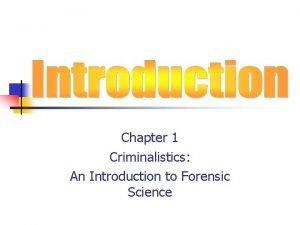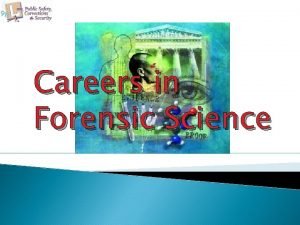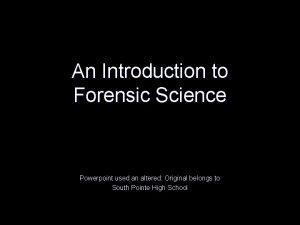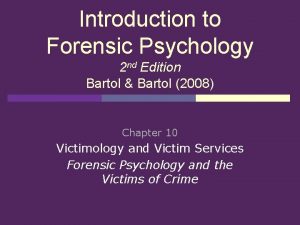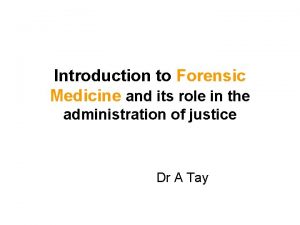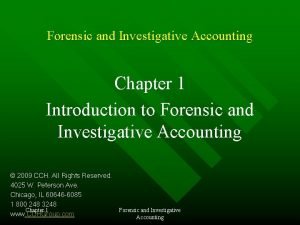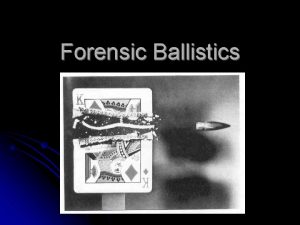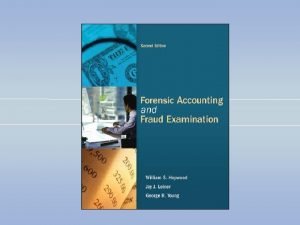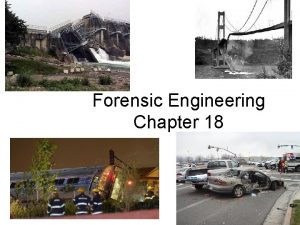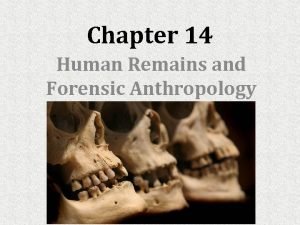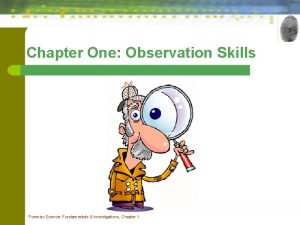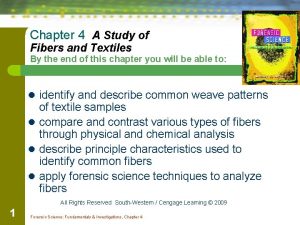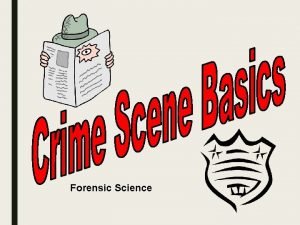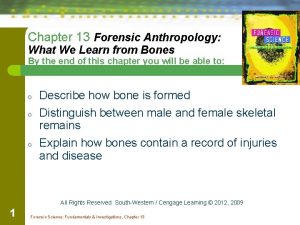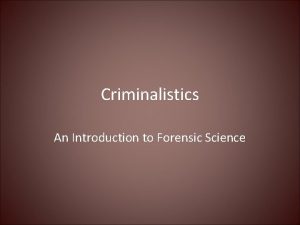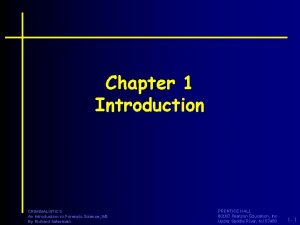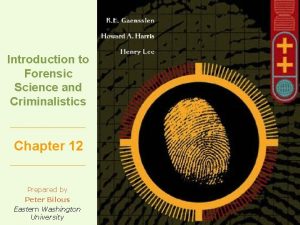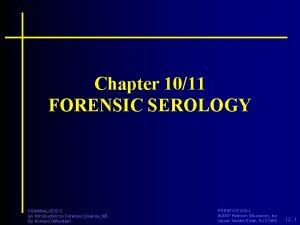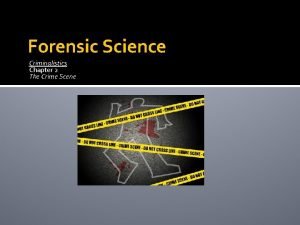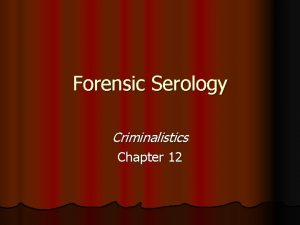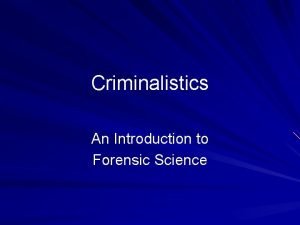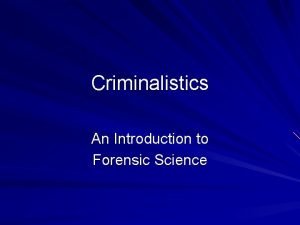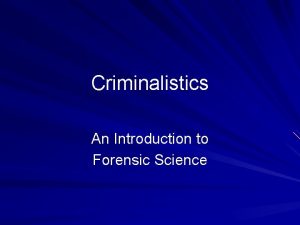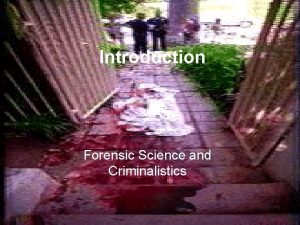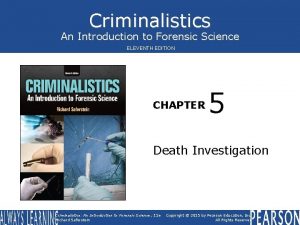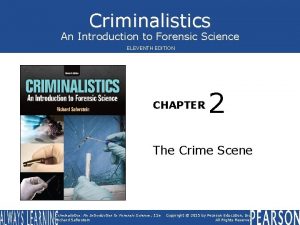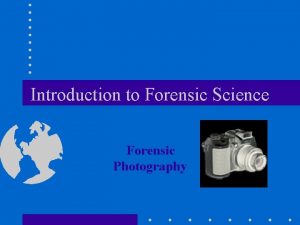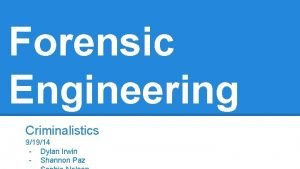Chapter 1 INTRODUCTION CRIMINALISTICS An Introduction to Forensic




















- Slides: 20

Chapter 1 INTRODUCTION CRIMINALISTICS An Introduction to Forensic Science, 9/E By Richard Saferstein PRENTICE HALL © 2007 Pearson Education, Inc. Upper Saddle River, NJ 07458 1 - 1

Definition • In its broadest definition, forensic science is the application of science to criminal and civil laws. • The subject matter of this book emphasizes the application of science to those criminal and civil laws that are enforced by police agencies in a criminal justice system. • Forensic science owes its origins to individuals such as Bertillon, Galton, Lattes, Goddard, Osborn, and Locard, who developed the principles and techniques needed to identify or compare physical evidence. CRIMINALISTICS An Introduction to Forensic Science, 9/E By Richard Saferstein PRENTICE HALL © 2007 Pearson Education, Inc. Upper Saddle River, NJ 07458 1 - 2

History • Mathieu Orfila—the father of forensic toxicology. • Alphonse Bertillion—devised the first scientific system of personal identification in 1879. • Francis Galton—conducted the first definitive study of fingerprints and their classification. • Leone Lattes—developed a procedure to determine blood type from dried bloodstains. • Calvin Goddard—used a comparison microscope to determine if a particular gun fired a bullet. • Albert Osborn—developed the fundamental principles of document examination. CRIMINALISTICS An Introduction to Forensic Science, 9/E By Richard Saferstein PRENTICE HALL © 2007 Pearson Education, Inc. Upper Saddle River, NJ 07458 1 - 3

History • Walter Mc. Crone—utilized microscopy and other analytical methodologies to examine evidence. • Hans Gross—wrote the first treatise describing the application of scientific principles to the field of criminal investigation. • Edmond Locard—incorporared Gross’ principles within a workable crime laboratory. • Locard’s Exchange Principle—states that when a criminal comes in contact with an object or person, a cross-transfer of evidence occurs. CRIMINALISTICS An Introduction to Forensic Science, 9/E By Richard Saferstein PRENTICE HALL © 2007 Pearson Education, Inc. Upper Saddle River, NJ 07458 1 - 4

The Crime Lab • The development of crime laboratories in the United States has been characterized by rapid growth accompanied by a lack of national and regional planning and coordination. • At present, approximately 350 public crime laboratories operate at various levels of government—federal, state, county, and municipal. CRIMINALISTICS An Introduction to Forensic Science, 9/E By Richard Saferstein PRENTICE HALL © 2007 Pearson Education, Inc. Upper Saddle River, NJ 07458 1 - 5

The Crime Lab • The ever increasing number of crime laboratories is partly the result of the following: – Supreme Court decisions in the 1960 s responsible for police placing greater emphasis on scientifically evaluated evidence. – Crime laboratories inundated with drug specimens due to accelerated drug abuse. – The advent of DNA profiling. CRIMINALISTICS An Introduction to Forensic Science, 9/E By Richard Saferstein PRENTICE HALL © 2007 Pearson Education, Inc. Upper Saddle River, NJ 07458 1 - 6

Technical Support • The technical support provided by crime laboratories can be assigned to five basic services. – Physical Science Unit incorporates the principles of chemistry, physics, and geology to identify and compare physical evidence. – Biology Unit applies the knowledge of biological sciences in order to investigate blood samples, body fluids, hair, and fiber samples. – Firearms Unit investigates discharged bullets, cartridge cases, shotgun shells, and ammunition. CRIMINALISTICS An Introduction to Forensic Science, 9/E By Richard Saferstein PRENTICE HALL © 2007 Pearson Education, Inc. Upper Saddle River, NJ 07458 1 - 7

Technical Support – Document Unit provides the skills needed for handwriting analysis and other questioneddocument issues. – Photographic Unit applies specialized photographic techniques for recording and examining physical evidence. Some crime laboratories may offer the optional services of toxicology, fingerprint analysis, voiceprint analysis, evidence collection, and polygraph administration. CRIMINALISTICS An Introduction to Forensic Science, 9/E By Richard Saferstein PRENTICE HALL © 2007 Pearson Education, Inc. Upper Saddle River, NJ 07458 1 - 8

Technical Support • Optional Services by Full-Service Labs – Toxicology Unit examines body fluids and organs for the presence of drugs and poisons. – Latent Fingerprint Unit processes and examines evidence for latent fingerprints. – Polygraph Unit conducts polygraph or lie detector tests. – Voiceprint Analysis Unit attempts to tie a recorded voice to a particular suspect. – Evidence-Collection Unit dispatches specially trained personnel to the crime scene to collect and preserve physical evidence. CRIMINALISTICS An Introduction to Forensic Science, 9/E By Richard Saferstein PRENTICE HALL © 2007 Pearson Education, Inc. Upper Saddle River, NJ 07458 1 - 9

Skills of a Forensic Scientist • A forensic scientist must be skilled in applying the principles and techniques of the physical and natural sciences to the analysis of the many types of evidence that may be recovered during a criminal investigation. • A forensic scientist may also provide expert court testimony. • An expert witness is an individual whom the court determines possesses knowledge relevant to the trial that is not expected of the average person. CRIMINALISTICS An Introduction to Forensic Science, 9/E By Richard Saferstein PRENTICE HALL © 2007 Pearson Education, Inc. Upper Saddle River, NJ 07458 1 -10

Skills of a Forensic Scientist • The expert witness is called on to evaluate evidence based on specialized training and experience that the court lacks the expertise to do. • The expert will then express an opinion as to the significance of the findings. • Forensic scientists also participate in training law enforcement personnel in the proper recognition, collection, and preservation of physical evidence. CRIMINALISTICS An Introduction to Forensic Science, 9/E By Richard Saferstein PRENTICE HALL © 2007 Pearson Education, Inc. Upper Saddle River, NJ 07458 1 -11

The Frye Standard • The Frye v. United States decision set guidelines for determining the admissibility of scientific evidence into the courtroom. • To meet the Frye standard, the evidence in question must be “generally accepted” by the scientific community. CRIMINALISTICS An Introduction to Forensic Science, 9/E By Richard Saferstein PRENTICE HALL © 2007 Pearson Education, Inc. Upper Saddle River, NJ 07458 1 -12

Frye Not Absolute • However, in the 1993 case of Daubert v. Merrell Dow Pharmaceutical, Inc. , the U. S. Supreme Court asserted that the Frye standard is not an absolute prerequisite to the admissibility of scientific evidence. • Trial judges were said to be ultimately responsible as “gatekeepers” for the admissibility and validity of scientific evidence presented in their courts, as well as all expert testimony. CRIMINALISTICS An Introduction to Forensic Science, 9/E By Richard Saferstein PRENTICE HALL © 2007 Pearson Education, Inc. Upper Saddle River, NJ 07458 1 -13

The Daubert Criteria • In Daubert, the Supreme Court offered some guidelines as to how a judge can gauge scientific evidence: 1) Whether the scientific technique or theory can be (and has been) tested. 2) Whether the technique or theory has been subject to peer review and publication. 3) The technique’s potential rate of error. CRIMINALISTICS An Introduction to Forensic Science, 9/E By Richard Saferstein PRENTICE HALL © 2007 Pearson Education, Inc. Upper Saddle River, NJ 07458 1 -14

The Daubert Criteria 4) Existence and maintenance of standards controlling the technique’s operation. 5) Whether the scientific theory or method has attracted widespread acceptance within a relevant scientific community. CRIMINALISTICS An Introduction to Forensic Science, 9/E By Richard Saferstein PRENTICE HALL © 2007 Pearson Education, Inc. Upper Saddle River, NJ 07458 1 -15

Special Forensic Science Services • A number of special forensic science services are available to the law enforcement community to augment the services of the crime laboratory. • These services include forensic pathology, forensic anthropology, forensic entomology, forensic psychiatry, forensic odontology, computer science, and forensic engineering. CRIMINALISTICS An Introduction to Forensic Science, 9/E By Richard Saferstein PRENTICE HALL © 2007 Pearson Education, Inc. Upper Saddle River, NJ 07458 1 -16

Special Forensic Science Services • Forensic Pathology involves the investigation of unnatural, unexplained, or violent deaths. – Forensic pathologists in their role as medical examiners or coroners are charged with determining cause of death. – The forensic pathologist may conduct an autopsy which is the medical dissection and examination of a body in order to determine the cause of death. CRIMINALISTICS An Introduction to Forensic Science, 9/E By Richard Saferstein PRENTICE HALL © 2007 Pearson Education, Inc. Upper Saddle River, NJ 07458 1 -17

Special Forensic Science Services • After a human body expires there are several stages of death. – Rigor mortis results in the shortening of muscle tissue and the stiffening of body parts in the position at death (occurs within the first 24 hours and disappears within 36 hours). – Livor mortis results in the settling of blood in areas of the body closest to the ground (begins immediately on death and continues up to 12 hours). – Algor mortis results in the loss of heat by a body (a general rule, beginning about an hour after death, the body loses heat by 1 to 1 -1/2 degrees Fahrenheit per hour until the body reaches the environmental temperature). CRIMINALISTICS An Introduction to Forensic Science, 9/E By Richard Saferstein PRENTICE HALL © 2007 Pearson Education, Inc. Upper Saddle River, NJ 07458 1 -18

Special Forensic Science Services • Forensic Anthropology is concerned primarily with the identification and examination of human skeletal remains. • Forensic Entomology is the study of insects and their relation to a criminal investigation, commonly used to estimate the time of death. • Forensic Psychiatry is an area in which the relationship between human behavior and legal proceedings is examined. CRIMINALISTICS An Introduction to Forensic Science, 9/E By Richard Saferstein PRENTICE HALL © 2007 Pearson Education, Inc. Upper Saddle River, NJ 07458 1 -19

Special Forensic Science Services • Forensic Odontology involves using teeth to provide information about the identification of victims when a body is left in an unrecognizable state; also investigates bite marks. • Forensic Engineering is concerned with failure analysis, accident reconstruction, and causes and origins of fires or explosions. • Forensic Computer Science involves the examination of digital evidence. CRIMINALISTICS An Introduction to Forensic Science, 9/E By Richard Saferstein PRENTICE HALL © 2007 Pearson Education, Inc. Upper Saddle River, NJ 07458 1 -20
 Forensic criminalist
Forensic criminalist American board of criminalistics
American board of criminalistics Forensic anthropologist vs forensic pathologist
Forensic anthropologist vs forensic pathologist Who is this
Who is this Chapter 1 introduction to forensic science and the law
Chapter 1 introduction to forensic science and the law Forensic science powerpoint
Forensic science powerpoint Introduction to forensic psychology bartol pdf
Introduction to forensic psychology bartol pdf Locard's exchange principle
Locard's exchange principle Forensic science an introduction
Forensic science an introduction Introduction to forensic medicine
Introduction to forensic medicine Journal of forensic and investigative accounting
Journal of forensic and investigative accounting What is ballistics?
What is ballistics? Introduction to forensic accounting
Introduction to forensic accounting Forensic science chapter 18 review answers
Forensic science chapter 18 review answers Nibis definition forensics
Nibis definition forensics Forensic anthropology unit
Forensic anthropology unit What is an observation in science
What is an observation in science Chapter 6 fingerprints
Chapter 6 fingerprints Weave patterns forensics
Weave patterns forensics Oconnors bakery
Oconnors bakery Chapter 13 forensic anthropology
Chapter 13 forensic anthropology
